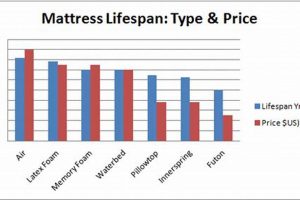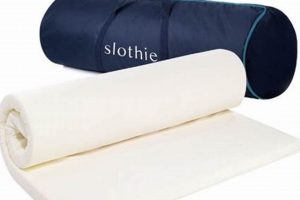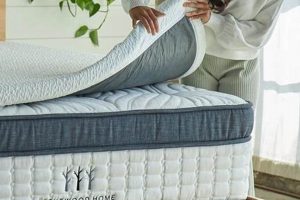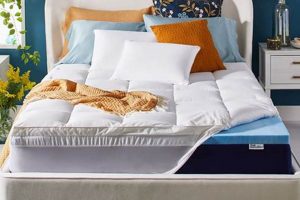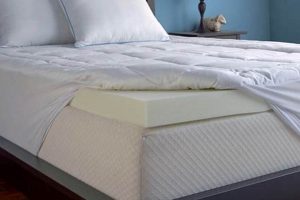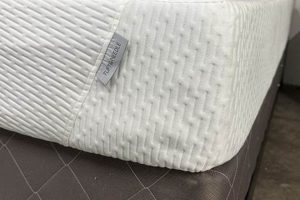A comparison between two distinct types of mattresses centers around their core construction materials. One option utilizes sap from rubber trees, processed to create a resilient and supportive sleep surface. The other employs viscoelastic polyurethane foam, engineered to conform to the body’s shape and distribute weight evenly. These materials offer differing characteristics in terms of feel, support, and temperature regulation, leading to diverse sleep experiences.
The significance of this comparison lies in understanding the unique advantages each material presents. Natural origins, potential durability, and breathability are often cited as benefits of one option. Conversely, pressure relief, motion isolation, and affordability are frequently highlighted as advantages of the other. Examining these distinctions provides consumers with the knowledge necessary to make an informed decision based on individual needs and preferences.
The subsequent sections will delve into specific aspects of each material. We will explore their respective properties related to support, comfort, temperature neutrality, durability, and cost. This detailed examination will provide a comprehensive overview of their strengths and weaknesses, ultimately aiding in the selection of a suitable mattress.
Choosing between two mattress types requires careful consideration of individual needs and priorities. The following tips offer guidance to facilitate a more informed selection process.
Tip 1: Prioritize Support Requirements: Assess the level of support required for optimal spinal alignment. One option typically provides a firmer, more responsive feel, while the other conforms closely to the body. Consider sleeping position and any existing back pain when evaluating support levels.
Tip 2: Evaluate Pressure Relief: Individuals experiencing joint pain or pressure point sensitivity should prioritize pressure relief. One choice excels at distributing weight evenly, minimizing stress on specific areas. Determine if this characteristic aligns with individual comfort needs.
Tip 3: Consider Temperature Sensitivity: Overheating during sleep can disrupt rest. One material naturally promotes airflow and dissipates heat more effectively, whereas the other tends to retain heat. Evaluate environmental factors and individual temperature preferences.
Tip 4: Assess Motion Isolation Needs: Shared sleeping surfaces necessitate consideration of motion transfer. One choice minimizes the transmission of movement, preventing disturbances caused by a partner’s tossing and turning. Determine the importance of motion isolation for undisturbed sleep.
Tip 5: Evaluate Durability Expectations: Mattress longevity represents a significant investment. One type is known for its resilience and ability to maintain its shape over time, potentially offering a longer lifespan. Factor in usage patterns and budget considerations when assessing durability.
Tip 6: Factor in Budgetary Constraints: Mattress prices vary widely. The natural option tends to be more expensive upfront. Establish a realistic budget and compare models within that range, considering long-term value and potential health benefits.
Tip 7: Research Certifications and Materials: Look for certifications ensuring that the products meet established standards. Verify the materials used in mattress construction and assess potential allergen risks.
In summary, making an informed decision requires understanding the distinct properties of each material. Consider factors such as support, pressure relief, temperature regulation, motion isolation, durability, and budget to identify the optimal mattress for individual needs.
The subsequent conclusion will synthesize the information presented, reinforcing key considerations for selecting the ideal sleep surface.
1. Support and Feel
The terms “support” and “feel,” when applied to the comparison of materials, represent fundamental qualities dictating the sleep experience. Support, in this context, refers to the mattress’s ability to maintain spinal alignment and prevent excessive sinking. Feel describes the tactile sensation experienced upon contact with the sleep surface, ranging from firm and responsive to soft and conforming. The interaction between these two properties is crucial, as optimal spinal alignment without a comfortable feel can be equally detrimental to restful sleep as a plush feel without adequate support.
Examining real-world applications, individuals with back pain often require mattresses with firmer support to prevent further aggravation. In this scenario, a material known for its buoyant and responsive nature, such as one derived from rubber trees, might be preferred. Conversely, individuals seeking pressure relief, particularly those with joint pain or pressure point sensitivity, may find the conforming properties of viscoelastic foam more suitable. An understanding of these differences allows consumers to align their mattress choice with specific physiological needs and comfort preferences. The consequences of disregarding support and feel can include discomfort, disrupted sleep, and potentially exacerbated physical ailments.
In summary, the relationship between support and feel is intrinsic to the decision-making process when comparing materials. A balanced approach that considers both spinal alignment and tactile comfort is essential. The absence of either component can compromise the overall sleep experience, emphasizing the need for thorough evaluation and informed decision-making. Understanding this interaction is paramount for selecting a mattress that promotes both physical well-being and restorative sleep.
2. Temperature regulation
Temperature regulation within a sleep environment is a significant factor influencing sleep quality. Mattress materials contribute substantially to this regulation. Consequently, the contrasting thermal properties of materials are critical considerations when comparing mattress options.
- Material Breathability
One key facet of temperature regulation lies in the inherent breathability of the materials. A material with open-cell structure allows for increased airflow, facilitating heat dissipation and reducing the likelihood of heat buildup. Conversely, denser materials with limited airflow may trap heat, leading to discomfort during sleep.
- Heat Retention Characteristics
Certain materials exhibit a tendency to retain heat. This characteristic is influenced by density and composition. High-density materials often possess greater heat retention capabilities, potentially causing sleepers to feel warmer throughout the night. Understanding a material’s heat retention profile is essential for individuals sensitive to temperature f
luctuations during sleep. - Moisture Wicking Properties
The ability of a material to wick away moisture also contributes to temperature regulation. Moisture accumulation can lead to discomfort and increased body temperature. Materials with moisture-wicking properties help to maintain a dry and comfortable sleep surface, promoting optimal thermal regulation.
- Surface Temperature Sensitivity
Some materials exhibit greater sensitivity to changes in ambient temperature. Such materials may become excessively warm or cold, depending on the surrounding environment. Understanding this sensitivity is crucial for individuals living in regions with significant temperature variations.
These facets, when considered in the context of mattress selection, highlight the importance of aligning material properties with individual thermal preferences. Variations in breathability, heat retention, moisture wicking, and surface temperature sensitivity ultimately determine the overall comfort and temperature regulation afforded by differing mattress types, thus influencing sleep quality.
3. Motion Isolation
Motion isolation, the capacity of a mattress to minimize the transfer of movement across its surface, is a crucial consideration, particularly for individuals sharing a bed. The effectiveness of motion isolation varies significantly between mattresses constructed from different materials. The contrasting properties of latex and memory foam directly impact the degree to which disturbances are contained.
- Material Density and Viscosity
Material density and viscosity are key determinants of motion isolation. High-density materials, particularly those exhibiting viscoelastic properties, tend to absorb and dissipate energy more effectively. Memory foam, known for its ability to conform to the body, excels at isolating movement due to its inherent damping characteristics. In contrast, the more responsive and buoyant nature of the alternative material may result in greater motion transfer. For example, a partner’s movement on one side of a viscoelastic mattress is less likely to be felt on the other side, compared to a mattress with greater resilience.
- Internal Structure and Construction
The internal structure of a mattress, including the presence of individually pocketed coils or support layers, can augment motion isolation capabilities. While the core material plays a primary role, the construction techniques employed can either enhance or diminish its effectiveness. A mattress incorporating individually wrapped coils, combined with a top layer of motion-isolating foam, provides an enhanced level of disturbance reduction. The absence of such features may compromise the ability to contain movement, regardless of the material’s inherent properties.
- Surface Conformity and Pressure Distribution
The ability of a mattress to conform to the body’s contours and distribute pressure evenly influences motion isolation. Materials that conform closely to the body’s shape minimize the potential for movement to generate widespread vibrations. Memory foam, known for its pressure-relieving properties, effectively reduces motion transfer by cradling the body and limiting the propagation of disturbances. In situations where a sleeper shifts position, the conforming nature of the material helps to absorb and dampen the resulting movements.
- Thickness and Density of Comfort Layers
The thickness and density of the comfort layers directly contribute to motion isolation. Thicker and denser layers provide greater cushioning and absorb more energy, reducing the transmission of movement. A mattress with substantial comfort layers, composed of high-density foam, offers superior motion isolation compared to a thinner mattress with less dense materials. This is particularly relevant for couples with significant weight or movement differences, where enhanced motion isolation can prevent sleep disruptions.
In conclusion, the efficacy of motion isolation is fundamentally linked to the material composition and construction of a mattress. While inherent material properties play a crucial role, structural design and comfort layer characteristics further influence the extent to which disturbances are contained. Understanding these factors is essential for individuals prioritizing undisturbed sleep, particularly in shared sleeping environments. By carefully evaluating the motion isolation capabilities of different mattress types, consumers can make informed decisions that align with their specific needs and preferences.
4. Durability assessment
Durability assessment, in the context of mattress selection, pertains to evaluating the lifespan and resistance to wear of different materials. With respect to mattresses, this assessment focuses on the ability of the core materials to retain their supportive qualities and structural integrity over an extended period. The selection of appropriate bedding constitutes a substantial investment, making durability a pivotal factor in the purchasing decision.
Specifically, when comparing materials used in mattress construction, durability assessment involves analyzing each material’s inherent resistance to degradation. One material, derived from natural rubber, possesses inherent resilience and the ability to withstand prolonged compression. In contrast, viscoelastic polyurethane foam, while offering initial comfort, may exhibit a gradual breakdown over time, leading to reduced support and potential sagging. The relative lifespan difference between these two options influences the overall value proposition. For instance, a mattress with greater longevity minimizes the frequency of replacement, resulting in long-term cost savings.
Consumers engaging in durability assessment should consider factors such as material density, manufacturing processes, and user weight. Higher density often correlates with greater resistance to wear. Manufacturing techniques that reinforce structural integrity contribute to extended lifespan. User weight and sleeping habits directly influence the rate of material degradation. In summary, durability assessment provides a framework for evaluating the long-term value of mattress materials, enabling informed decisions that align with individual needs and budgetary constraints.
5. Cost comparison
The cost comparison between latex and memory foam mattresses reveals a notable disparity, influencing consumer choices. This price differential stems from variations in raw material sourcing, manufacturing complexity, and overall product lifespan. Latex, particularly that derived from organic sources, incurs higher raw material costs due to cultivation and processing requirements. Manufacturing processes for latex mattresses often involve specialized techniques to ensure uniform density and structural integrity. Conversely, memory foam production benefits from economies of scale and simpler manufacturing procedures, resulting in lower production costs. These factors collectively contribute to the higher retail price typically associated with latex mattresses.
Analyzin
g the relationship between cost and longevity further clarifies the comparison. While memory foam mattresses present a lower initial investment, their lifespan is often shorter than that of latex counterparts. Over time, memory foam can exhibit signs of degradation, such as sagging or reduced responsiveness, necessitating earlier replacement. Latex, known for its durability and resilience, maintains its supportive qualities for a longer period. Consequently, the long-term cost of ownership may be lower for latex mattresses, despite the higher upfront expense. Consumers prioritizing long-term value should factor in this difference when evaluating the cost-effectiveness of each option. Instances where budget constraints necessitate immediate savings may lead to the selection of memory foam, whereas those considering long-term expenditure often favor latex.
In summary, the cost comparison between latex and memory foam mattresses extends beyond the initial purchase price. Factors such as raw material sourcing, manufacturing processes, product lifespan, and long-term value all contribute to the overall cost equation. While memory foam presents a more affordable entry point, latex offers potential long-term savings due to its enhanced durability. Navigating this comparison requires a thorough understanding of individual budgetary constraints, anticipated usage patterns, and long-term investment goals. The ultimate selection hinges on balancing affordability with durability to optimize value.
Frequently Asked Questions
This section addresses common inquiries surrounding the comparison between latex and memory foam mattresses, providing concise and factual responses.
Question 1: Is a mattress inherently superior in terms of orthopedic support?
Neither material holds an absolute advantage regarding orthopedic support. The suitability of each depends on individual spinal alignment needs and preferred sleeping positions. Firmer support may benefit back sleepers, while conforming support may suit side sleepers.
Question 2: Does one of two products universally offer better temperature regulation?
No universal advantage exists. Latex generally exhibits greater breathability, promoting airflow. Memory foam may retain heat due to its density. Personal temperature sensitivity and environmental conditions influence the ideal choice.
Question 3: Which product consistently proves more durable under varied conditions?
The durability varies depending on density, manufacturing, and usage. Latex, in general, displays greater resilience and resistance to degradation. Memory foam may exhibit sagging over time. Assess manufacturer warranties and user reviews for insights.
Question 4: Is it true that is always more expensive?
Generally, latex mattresses command a higher initial price due to raw material and processing costs. Memory foam mattresses tend to be more budget-friendly. However, long-term value considerations may shift the overall cost equation.
Question 5: Which type of mattress typically offers superior motion isolation?
Memory foam typically exhibits superior motion isolation due to its viscoelastic properties. Latex, with greater responsiveness, may transmit more movement. Co-sleeping individuals often prioritize motion isolation characteristics.
Question 6: Are there specific health or environmental concerns associated with either material?
Potential concerns exist for individuals with latex allergies. Certifications ensure materials meet safety standards. Memory foam may contain volatile organic compounds (VOCs); consider options with low-VOC certifications. Research material composition and potential allergens before purchase.
In summary, the selection between latex and memory foam mattresses necessitates careful consideration of individual needs and priorities. No single material universally excels across all parameters. Informed decision-making requires a thorough understanding of the unique properties of each option.
The subsequent conclusion will synthesize the information presented, reinforcing key considerations for selecting the ideal sleep surface.
Conclusion
The preceding exploration has delineated the critical distinctions between these distinct mattress materials. While both offer viable sleep solutions, their suitability hinges on aligning material properties with individual requirements. Key considerations encompass support needs, temperature sensitivities, motion isolation preferences, durability expectations, and budgetary constraints. A comprehensive understanding of these factors is paramount in discerning the optimal sleep surface.
Ultimately, the selection represents a personalized decision. Continued research and critical evaluation of individual needs will yield the most satisfactory outcome. The significance of informed decision-making cannot be overstated, as the chosen mattress directly impacts sleep quality and overall well-being. Prioritize understanding, and the correct choice will materialize.


